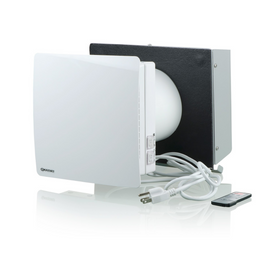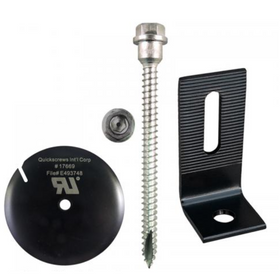
Minneapolis Net Zero House
Last Updated: Feb 8, 2025Not many people have the opportunity to build their own homes, much less a second one. The magic happened for homeowners Mark and Kate Hanson when they were able to take what they learned from their first home building experience, and apply it to their next home. According to Mark Hanson, "Regardless of your focus on the environment, a Net Zero house is more comfortable, healthier, and easier to live in."
Table of Contents
- It's All About Setting Goals
- Finding the Perfect Site
- Designing the Home
- Costs and Benefits
- The Coolest Car on the Planet
- The Cool Factor x Two

When the Hanson's built their first home in a suburb of Minneapolis, Minnesota, back in 2006, they were not trying to get to Net-Zero. The concept had hardly been on anyone's radar over a decade ago. But they wanted it to be as energy-efficient as possible. So, they installed spray foam insulation, geothermal, and solar panels. "It was basically like taping energy efficiency post-it notes onto a house," says Mark.

When they decided to move closer to the city to reduce their commute times, they were well versed in sustainable home building and design. Their thinking had evolved, technologies had improved, and they got a second shot at building their dream home. This time, they hit the trifecta, with the admirable certifications and awards of LEED Platinum (version 4), Minnesota Greenstar Home (Gold), and Living Building Challenge Zero Energy Certification. How did that happen? They set goals and thoughtfully planned the design of the home.

It's All About Setting Goals
The primary goal for the Hansons was to have a truly Net Zero energy home, but it didn't stop there. They wanted the house to be Net Zero, including the ability to charge their two electric vehicles, their electric lawnmower and snowblower.
Energy Saving Products for the Home
Shop home improvement products that help save and conserve energy (power) in your home.

Vents TwinFresh Comfo RA1-50-2 Ductless Energy Recovery Ventilator
Vents
In Stock

Stiebel Eltron Accelera 300 E Heat Pump Water Heater
Stiebel Eltron
Out of Stock

AFM Safecoat Almighty Adhesive Case of 12
AFM Safecoat
In Stock

Emporia Classic Level 2 48 AMP EV Charger UL Listed
Emporia
In Stock
2 Colors

Stiebel Eltron CON 300-2 Premium Wall-Mounted Convection Heater - 202030
Stiebel Eltron
Out of Stock

Santa Fe Compact70 Dehumidifier - 4044110
Santa Fe
In Stock

AFM Safecoat 3 in 1 Adhesive
AFM Safecoat
In Stock

QuickBOLT QB2 with Microflashing Multi Roof Mount Solar Panel Fastener Kit
QuickBOLT
In Stock

Stiebel Eltron DHC-E 8/10-2 Plus Point-of-Use Electric Tankless Water Heater - 202145
Stiebel Eltron
In Stock

Stiebel Eltron Accelera 220 E Heat Pump Water Heater
Stiebel Eltron
In Stock

To meet their stormwater management goal, the egress windows in the basement have large window wells, with boulders as a retaining wall, and native plants for soaking up runoff water. The large basement windows also let in light and warmth from the southern sun in the winter.
The bigger component, though, is the rain garden swale on their property. With the help of the city, they were allowed a few curb cuts to let stormwater from the street run onto their property. The small bit of grass that they do have is tall fescue, a species of turf that does not have to be mowed or watered as much as conventional turfgrass.
Building on Kate's training in holistic health, they designed a beautiful meditation circle in the back yard.
Costs and Benefits
The cost of creating a healthy, Net Zero, or in their case, net negative energy home has come down. The Hansons estimate they paid about 15 percent more for their home than one built to code, but that the incremental costs could quickly be recouped through lower operating costs. Their electricity is free.
In addition to lower operating costs, they get to live with less maintenance. LED lights mean they never have to change a light bulb. No gas appliances mean no pilot light to fix and cleaner indoor air. Healthier indoor air means air filters do not need to be changed as frequently. And ground source heat pumps mean no outside air conditioner to cleanout.
They seem to have gotten everything right this time. So much so, that Mark started a blog to share his knowledge and show that it is not so hard.

The Coolest Car on the Planet
We would shortchange our readers, though, without covering one of the coolest things on earth right now: Mark's Tesla.
The backstory: Ed Hawkins, a professor in the United Kingdom, wanted to help people visualize global warming. So, he figured out a way to graphically represent the changes in global temperatures over time. Accomplished by using stripes, each year has its own stripe. Blue is colder than average, and red is warmer. Mark spotted this artistic rendering of global warming from a news article that showed a group of meteorologists wearing ties that sported these stripes. That gave him an idea: could his Tesla have those same stripes? He called up the professor to make sure it was okay with him, called the car shop to see if they could do it, and…voila, an electric vehicle that speaks volumes.
Melissa Rappaport Schifman
Melissa became the Twin Cities’ fifth LEED for Homes Accredited Professional (LEED AP) and completed the work necessary to get her own home LEED Gold Certified, the basis for her book, Building a Sustainable Home: Practical Green Design Choices for Your Health, Wealth, and Soul, (Skyhorse Publishing, August, 2018). With her corporate experience in finance, marketing, and business development, and an MBA and Master’s in Public Policy from the University of Chicago, Melissa has been providing sustainability advisory services to businesses, governmental agencies and non-profits, focusing on strategic and operational change that provide bottom-line financial returns. She has led the LEED certification of two million square feet of commercial buildings, written GRI-compliant Corporate Sustainability Reports, is a LEED Pro Reviewer and LEED mentor with the U.S. Green Building Council. She is the founder of Green Intention LLC where she writes about sustainable home living.









